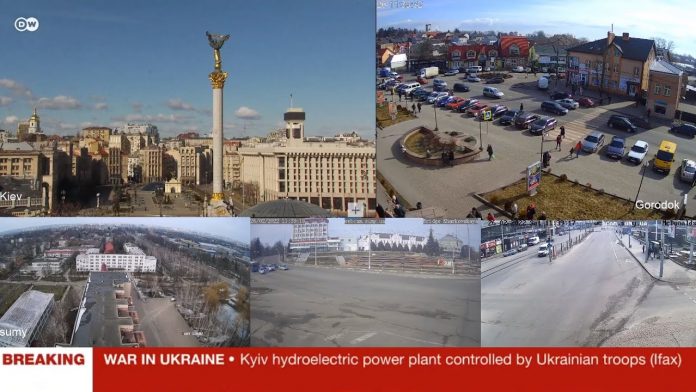Analysts and researchers are providing real time updates on Russia’s military assault on Ukraine by using open-source intelligence
By Umberto Bacchi
TBILISI – (Thomson Reuters Foundation) – When data enthusiast Oliver Alexander saw online security camera footage showing military trucks on a Ukrainian road hours after Russia launched its military assault, he noticed a familiar detail.
“You could see that they had diagonal lines painted on them, which is what was spotted on units based in Crimea. So you could tell they were coming from there,” Alexander said by phone, to the Russian-annexed Crimean Peninsula.
The 28-year old took some stills and posted them on Twitter, marking the location they were taken and giving his followers a sense of the speed at which Russian forces were moving north.
His tweet was one of a torrent that have been posted online over the past 48 hours by internet sleuths using a practice known as open-source intelligence (OSINT) to document the Russian invasion.
“(OSINT) has been really phenomenally deployed in a way that we haven’t seen before,” said Justin Crow, a researcher at Sussex University in Britain whose work focuses on social media intelligence, referring to the Ukraine conflict.
Moscow unleashed the biggest attack on a European state since World War Two on Thursday, shocking the world and prompting tens of thousands of people to flee their homes.
‘MAGNIFYING GLASS’
The OSINT sector has boomed in recent years with the development of tools aiding data analysis, and is now crowded by reporters, activists, researchers and amateur enthusiasts – who often work together as they try to verify information.
The work entails gathering publicly available resources, such as social media videos and photos, and looking at it through “a real time magnifying glass”, said Crow.
That could include, for example, analysing metadata to find out when or where a video was taken or cross-referencing images with satellite photos to verify locations and contextualise footage, he said.
“(OSINT’s) role is really about clarifying information for the broader public because … governments have this capability in house already,” said Crow.
Before missiles started pounding Ukraine, OSINT sleuths played an important role keeping tabs on the military buildup that led to the invasion, assessing troop deployments with satellite images.

When Russia invaded this week, their main focus became trying to document and make sense of the events unfolding on the ground, said Alexander, a financial analyst from Denmark with a passion for data analysis.
“Now, probably the most important thing that (OSINT) can be used for is documenting civilian casualties,” he said.
Clips circulating online include videos appearing to show a tank running over a moving car as well as footage of a cyclist hit by an explosion and of an unexploded rocket falling in a residential area.
On Friday, International Criminal Court (ICC) prosecutor Karim Khan said his court may investigate possible war crimes in Ukraine.
The United Nations said it had reports of at least 127 civilian casualties – 25 killed and 102 injured – “caused by shelling and air strikes”.
“We’ll endeavour to ensure any open source evidence is collected, archived, and made accessible to any accountability body that needs it, including the ICC,” Eliot Higgins, founder of OSINT media outlet Bellingcat, wrote on Twitter.
DEBUNKING
Open-source site Oryx has been keeping a record of vehicles, aircrafts and equipment destroyed or captured by Russian or Ukrainian forces – based on available online images.
Debunking false claims and propaganda has also been a key focus of OSINT detectives’ work.
When pro-Russian separatists in eastern Ukraine released a video purporting to show a foiled sabotage operation last week, amid Western intelligence charges that Russia was looking for a pretext to attack, online sleuths quickly suggested it was fake.
Metadata from the clip indicated it had been filmed days earlier, while an audio analysis revealed the sound of gunfire and explosions had been lifted from a YouTube video of Finnish military exercises, according to Bellingcat.
The flurry of content seems to have been too much to digest for Twitter content moderators, who have been involved in an effort of their own to spot false and misleading information.
Numerous old clips showing past military actions have reportedly appeared on the social media platform since Thursday, with captions claiming the images showed current events.
On the eve of the Russian invasion, the social media company suspended about a dozen OSINT accounts, including that of Alexander, in what it later said was a mistake.
“We’ve been proactively monitoring for emerging narratives that are violative of our policies, and, in this instance, we took enforcement action on a number of accounts in error,” Twitter said in a statement.








